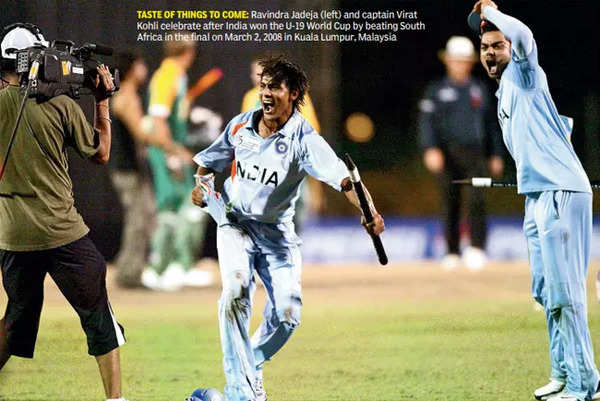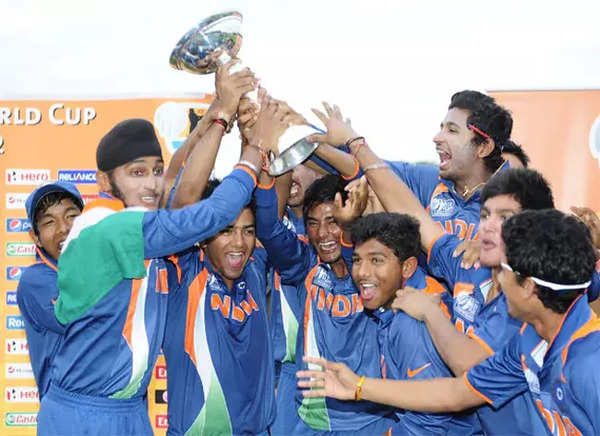Over the years, many players who have done well at the
U-19 World Cup
have graduated to the senior stage with spectacular success, while others showed promise but lost their way. TOI takes a look…
India’s under-19 cricketers have once again reached the final of the World Cup. This Sunday in Benoni in South Africa, Uday Saharan and Co. will have the opportunity to lift the title one more time.
Other than the skipper himself, players like Musheer Khan, Sachin Dhas, Arshin Kulkarni, Saumy Pandey and Naman Tiwari have also impressed. This is the ninth time India’s junior cricketers have reached the final, a record. They’ve also triumphed five times, another record. Which ones will graduate to the big league from here? Which ones will disappear? The under-19 World Cup stage is a fascinating story of both stalwarts and also-rans…
THE ONES WHO MADE IT BIG
VIRAT KOHLI
The biggest contribution the U-19 World Cup has had on Indian cricket is the emergence of Virat Kohli. It was in 2008 that Virat led India to their second U-19 WC title in Malaysia, where his team defeated South Africa in the final. He was India’s second highest run-scorer (235 runs, avg. 47, SR 94.75) and the lone century-scorer. The sight of Virat running towards pacer Siddarth Kaul after the final South African wicket fell is etched in India’s cricket folklore.

YUVRAJ SINGH
In the first indication that he was ready for many match-winning exploits at the senior level, Yuvraj Singh helped India to their maiden U-19 World Cup title in 2000. The southpaw was a vital cog in the Mohammad Kaif-led side that defeated Sri Lanka by six wickets in the final in Colombo. Yuvraj was Man of the Series, scoring 203 runs at an yet-unheard strike rate of 103.57. He also took 12 wickets with his left-arm spin and was the sixth highest wicket-taker.
VIRENDER SEHWAG
One of Indian cricket’s batting greats, Sehwag featured in the 1998 edition of the event in South Africa. More than his batting, Sehwag delivered with his off-spin, snaring seven wickets at a stingy economy-rate of 3.36. India didn’t make the final but Sehwag’s all-round skills got a lot of attention.
HARBHAJAN SINGH
Off-spinner Harbhajan also impressed in the 1998 edition, picking up eight wickets at an average of 21.12 and an economy rate of 3.44. Harbhajan had telling contributions in all five Indian victories. Soon after, Harbhajan made his Test debut for India against Australia in Bangalore.
ROHIT SHARMA
Batting at No. 3, India’s current captain hit three half-centuries in six innings at the 2006 U-19 World Cup in Sri Lanka. He tallied 205 runs at an average of 41. India managed to reach the final but lost to Pakistan by 38 runs. He also shone with his off-spin, picking up four wickets.
RAVINDRA JADEJA
The ‘Rockstar’ allrounder was involved in two U-19 World Cups –in 2006, in which India lost in the final, and the other in 2008, when India won under Kohli’s leadership. In 2006, Jadeja played four matches, picked up four wickets and also made some handy contributions down the order. By 2008, he had improved dramatically and was one of the stars with the ball, taking 10 wickets in six games. He was Kohli’s go-to man, and in the final got two important middle-order wickets to derail South Africa’s chase of 160.
CHETESHWAR PUJARA
Very few would believe Cheteshwar Pujara once scored runs at a faster clip than Rohit Sharma. This happened in the 2006 U-19 World Cup when Pujara, opening the batting, notched up 349 runs in six innings at a strikerate of 82.11. In comparison, Rohit’s strikerate was 77.35. Pujara hit one century and two half-centuries to finish as the highest run-scorer. But he failed in the final and was out for nought as India collapsed for 71.
SHIKHAR DHAWAN
Right from his U-19 days, Shikhar Dhawan had a penchant for scoring big at ICC events. In the 2004 U-19 World Cup, he was the highest run-getter with 505 runs in seven innings. His best knock was a swashbuckling unbeaten 155 against Scotland, apart from two other centuries. Dhawan had to wait to play for the senior side, though.
SURESH RAINA
Another big name from the 2004 U-19 World Cup who went on to play at the senior level. Raina was India’s second-highest run-scorer after Dhawan, scoring 247 runs at an average of 35.28 and a strike-rate of 90.80, including three halfcenturies. His knocks in the middle-order came at a fast clip. Raina also picked up five wickets with his offspin and played a crucial role in breaking partnerships. India lost in the semifinal but the 2004 team was one of the best-ever.
RISHABH PANT
India’s march to the final of the 2016 edition in Bangladesh, where they lost to West Indies U-19, was on the back of some explosive batting from opener Pant, who scored 267 runs in six innings at 44.50 (SR 104.29), including a century and two half-centuries. He formed a deadly opening combination with another big-hitter and wicketkeeperbatsman, Ishan Kishan. Just one year later, Pant got his senior India breakthrough.
THOSE WHO FADED AWAY
UNMUKT CHAND
Captain of the 2012 U-19 World Cup-winning team, Unmukt scored a matchwinning century (111 off 130 balls) in the final against hosts Australia. His superb performance earned him high praise from the likes of Aussie legend Ian Chappell, who said Chand was ready for the big stage. He returned home to massive media glare, wrote a book titled ‘The Sky Is the Limit: My Journey to the World Cup’. But his bat stopped yielding runs at the domestic level and Chand just couldn’t convert his teenage stardom into meaningful performances. He has now moved to the USA to play in the Major League Cricket and hopes to represent America at the international stage.

ASHOK MENARIA
The stylish Udaipur-born southpaw captained the Indian team at the 2010 U-19 World Cup in New Zealand. That team had many players who went on to don national colours. The likes of KL Rahul, Mayank Agarwal, Mandeep Singh and Jaydev Unadkat made it big, but not Menaria himself. He had a dismal tournament, scoring just 31 runs in five innings. It was one of the most disappointing U-19 World Cup campaigns as India finished sixth. Later, Menaria represented Rajasthan at the first-class level before a feud with the state board made him change states and move to Haryana.
VIJAY ZOL
Hailing from the small town of Jalna in Maharashtra, which had no cricket facilities to speak of, Zol first hit the headlines when he scored a monumental 451 in a Cooch Behar Trophy U-19 game in 2011. He went on to lead the team at the 2014 U-19 World Cup in the UAE, where India bowed out in the quarterfinals. His teammates Kuldeep Yadav, Shreyas Iyer and
Sanju Samson
all went to play for the national team, but not Zol. He started his first-class career on a brilliant note, scoring a century on debut for India ‘A’ against New Zealand ‘A’. He then hit a double-century on Ranji debut for Maharashtra. He was also picked by Royal Challengers Bangalore in 2014, but everything went downhill thereafter. He has not played a single first-class match since 2019. Last year, Zol was controversially booked on charges of kidnapping and extortion in Aurangabad.
SANDEEP SHARMA
The wily medium-pacer from Punjab made everyone stand up and take notice when he swung the ball prodigiously during the 2012 edition in Australia. Sharma picked up 12 wickets from six matches at an average of 15.75 (ER 3.62). His best came in the final when his 4/54 restricted Australia to a below-par score of 225/8, which India scaled on the back of Unmukt Chand’s century. Sharma was signed by Kings XI Punjab ahead of the 2013 IPL season. He has also represented Sunrisers Hyderabad and Rajasthan Royals. At the first-class level, he has come up with decent performances. Sharma was rewarded with two T20I caps against Zimbabwe in 2015, but failed to deliver in those matches and was not selected again.
SIDDARTH KAUL
He was Virat Kohli’s trusted man in the pace department during the victorious 2008 U-19 campaign. Kaul picked up 10 wickets in five games at 15.40 (ER 4.27). He had made his first-class debut for Punjab even before the U-19 World Cup and was rewarded for his domestic performances with three ODIs and three T20Is in 2018-19. However, he couldn’t crack the code at the international stage and was subsequently dropped. He has, however, played for four different IPL teams.









 English (US) ·
English (US) ·